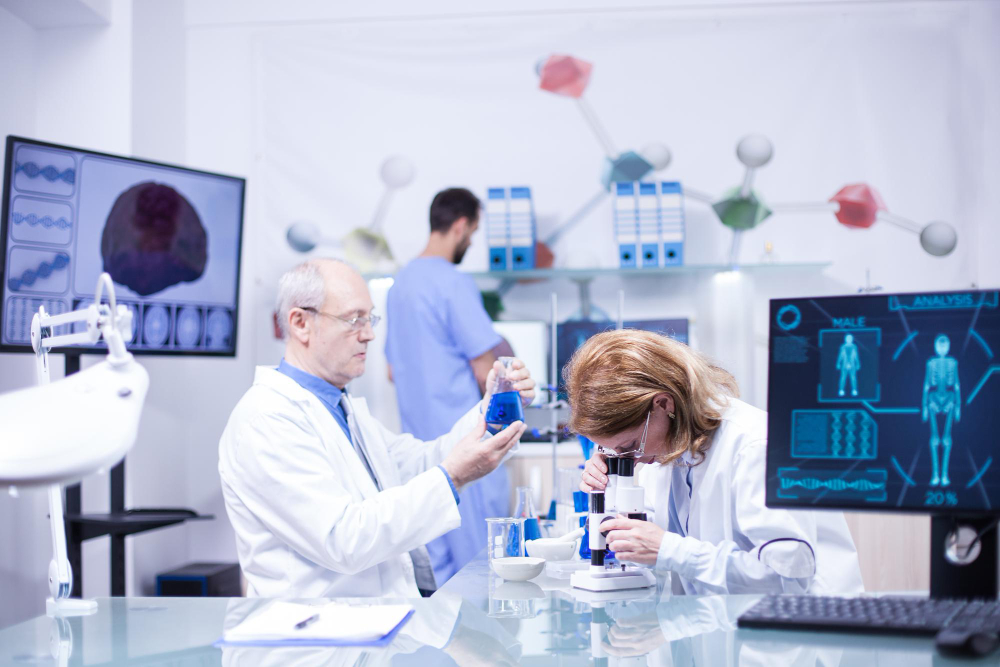Table of Contents
Toggle유전자 번역에 대해서 알아 보겠습니다(영어번역)
.

유전자 번역(영어 원본)<Roger D. Kornberg> The fundamental basis of gene regulation, including the control of transcription as the first step in the pathway of gene expression, constitutes the research focus of Roger D. Kornberg, Ph.D., the Mrs. George A. Winzer Professor in Medicine and professor of structural biology at Stanford University School of Medicine. “You can’t understand a machine if you don’t know the place of all the pieces, and our discoveries have helped locate the parts of the machine that makes RNA,” Dr. Kornberg says. In elucidating the inner workings of RNA, his research team has isolated the proteins responsible for transcription and gene regulation, including those that form a mediator to regulate the process. His research also helps explain how disease can result when transcription goes awry and offers the potential for unlocking new therapeutic approaches. Dr. Kornberg earned his Ph.D. in chemistry from Stanford University. Following postdoctoral work at the MRC Laboratory of Molecular Biology in Cambridge, England, he joined the scientific staff there. He later became part of the faculty in the Department of Biological Chemistry at Harvard Medical School and eventually returned to Stanford as professor of structural biology. His recent honors include the General Motors Cancer Research Foundation’s Alfred P. Sloan Jr. Prize, the Pasarow Award in Cancer Research from the Pasarow Foundation, and Le Grand Prix Charles-Leopold Mayer from the Académie des Sciences in France. He also is a co-recipient of the Merck Award from the American Society for Biochemistry and Molecular Biology. Dr. Kornberg is a member of the National Academy of Sciences and a fellow of the American Academy of Arts and Sciences. <Robert Huber> Robert Huber was born in 1937 in Munich. He studied chemistry at the Technische Universität München (TUM), where he also completed his Ph.D. and habilitation. Since 1972, he has been a member of the Max-Planck-Gesellschaft and Director at the Max-Planck-Institut für Biochemie until his retirement in 2005. Since 1976, he also serves at the TUM as a Professor. He holds appointments as Guest Professor at the Universität Duisburg-Essen (Germany), the Cardiff University (Great Britain), and the Universidad Autonoma de Barcelona (Spain). He serves as a member of the Board and/or Scientific Advisory Board of a number of pharmaceutical and crop science companies, and he is co-founder of two companies, Proteros and Suppremol, located in Martinsried and offering services for drug discovery and development and for the development of novel therapies for autoimmune diseases, respectively. Huber has made major contributions to the understanding of the structure and function of biological macromolecules. He has studied proteases and their natural and synthetic inhibitors, metalloenzymes (iron, nickel, molybdenum, copper), proteins of the immune system (antibodies and antibody receptors), protein hormones and their receptors, protein kinases, enzymes of amino acid biosynthesis, enzymes of cofactor and vitamin biosynthesis and proteins of energy and electron transfer. In addition, he has contributed to the development of instruments for data collection and to methods in protein crystallography, particularly Patterson methods, graphic methods, and refinement, to the use of electron rich metal clusters, and most recently to the methods and instruments for crystal improvement. He has been honoured by numerous honorary doctorates, professorships, memberships in learned societies and awards, including the Otto-Warburg Medal, the Emil von Behring Medal, the Sir Hans Krebs Medal, the The Linus Pauling Medal, Max Tishler Prize and, in 1988, the Nobel Prize for Chemistry together with H. Michel and J. Deisenhofer. |
유전자 번역(한국어 번역본)<Roger D. Kornberg> 스탠포드 대학 구조 생물학과 교수이자 의대 교수인 George A. Winzer와 Roger D. Kornberg 박사의 연구는 유전자 발현 경로의 첫 단계인 전사 조절을 포함해 유전자 조절의 기본 원리에 초점을 두고 있다. Kornberg 박사는 “전체를 알지 못한다면 여러분은 기계(machine)를 이해하지 못할 것입니다. 그리고 우리의 발견은 RNA를 만드는 일부 기계의 위치를 밝히는데 도움이 되었습니다.”라고 말하였다. RNA의 내부 활동을 해명하면서 그의 연구팀은 과정을 조절하기 위해 매개체를 형성하는 것들을 포함해 유전자 조절과 전사를 담당하는 단백질을 분리시켰다. 그의 연구는 또한 전사가 실패하는 경우, 어떻게 질병이 발생될 수 있는지를 설명하고, 새로운 치료 접근법을 해명할 수 있는 가능성을 제시하는 데에도 도움이 된다. Kornberg 박사는 스탠포드 대학에서 화학박사 학위를 받았다. 그는 영국 캠브리지 MRC 분자생물학 연구소에서 박사후 과정을 거친 후 그곳의 연구원으로 참가하였다. 훗날 그는 하버드 의과대학의 생물화학과 교수가 되었으며, 이후 스탠포드 대학으로 돌아가 구조 생물학과 교수가 되었다. 그는 최근 제너럴 모터스 암 연구재단으로부터 Alfred P. Sloan Jr 상을, Pasarow 재단으로부터는 Pasarow 상을, 프랑스 Académic des Sciences로부터 Le Grand Prix Charles-Leopold Mayer 상을 수상하는 영예를 안았다. 그는 또한 미국 생화학 분자생물학회로부터 Merck 상을 공동 수상하기도 하였다. Kornber 박사는 미국 과학원의 회원이자 미국 학술원의 특별 회원이다. <Robert Huber> Rober Huber는 1937년 뮌헨에서 태어났다. 그는 뮌헨 공과대학 (TUM)에서 화학을 전공하였으며, 그곳에서 박사학위와 교수학위를 받았다. 1972년부터 그는 막스 플랑크 연구소의 회원이었으며, 2005년 은퇴를 하기 전까지 막스 플랑크 생화학연구소의 소장을 역임하였다. 또한 그는 1976년부터 TUM에서 교수로 재직 중에 있다. 그는 뒤스부르크 에센 대학 (독일), 카디프 대학 (영국), 바르셀로나 자치대학 (스페인)에서 객원교수로 임명되었다. 그는 여러 제약회사와 작물과학 관련 기업들에서 임원 및/또는 과학 자문위원회의 위원으로 활동하고 있으며, Martinstied에 위치해 있는 두 기업 Proteros 사와 Suppremol 사를 공동 설립하였다. Proteros 사는 신약 후보 물질의 발굴 및 개발에 관한 서비스를 제공하며, Suppremol 사는 새로운 자가면역 질환 치료법의 개발에 관한 서비스를 제공하는 기업이다. Huber는 생체 고분자의 기능과 구조를 이해하는데 커다란 기여를 하였다. 그는 프로테아제와 프로테아제의 천연 억제제 및 합성 억제제, 금속 효소 (철, 니켈, 몰리브덴, 구리), 면역체계 단백질 (항체, 항체 수용체) 단백질 호르몬, 단백질 호르몬 수용체, 단백질 키나아제, 아미노산 생합성 효소, 보조인자 효소, 비타민 생합성 그리고 에너지 단백질과 전자 전달을 연구하였다. 이외에도 그는 자료 수집 도구 개발과 단백질 결정 조사 방법 특히, Patterson 방법 및 그래픽 방법의 개발 그리고 정제와 전자가 풍부한 금속 클러스터의 이용에도 기여를 하였으며, 가장 최근에는 결정 향상 도구와 방법의 개발에도 공헌을 하였다. 그는 다수의 명예 박사학위와 교수직, 학술단체 회원이라는 영예와 Otto-Warburg 메달, Emil von Behring 메달, Sir Hans Krebs 메달, Linus Pauling 메달, Max Tishler 상 등을 수상하였으며, 1988년에는 H. Michel, J. Deisenhofer과 함께 노벨 화학상을 수상하는 영광을 차지하였다. |
.
이상 생화학회에서 의뢰한 유전자 번역(한영번역)의 일부를 살펴 보았습니다.